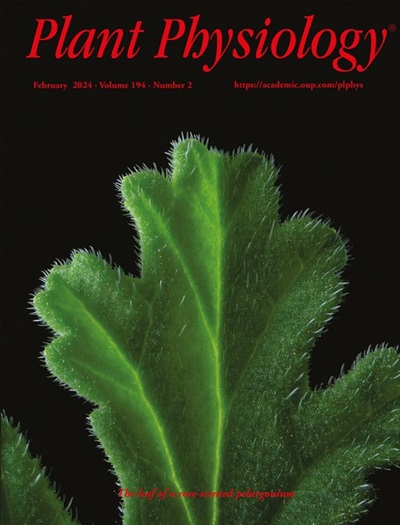The receptor MIK2 interacts with the kinase RKS1 to control quantitative disease resistance to Xanthomonas campestris
IF 6.5
1区 生物学
Q1 PLANT SCIENCES
引用次数: 0
Abstract
Molecular mechanisms underlying qualitative resistance have been intensively studied. In contrast, although quantitative disease resistance (QDR) is a common, durable and broad-spectrum form of immune responses in plants, only a few related functional analyses have been reported. The atypical kinase Resistance related KinaSe1 (RKS1) is a major regulator of QDR to the bacterial pathogen Xanthomonas campestris (Xcc) and is positioned in a robust protein-protein decentralized network in Arabidopsis (Arabidopsis thaliana). Among the putative interactors of RKS1 found by yeast two-hybrid screening, we identified the receptor-like kinase MDIS1-Interacting Receptor-like Kinase 2 (MIK2). Here, using multiple complementary strategies including protein-protein interaction tests, mutant analysis, and network reconstruction, we report that MIK2 is a component of RKS1-mediated QDR to Xcc. First, by co-localization experiments, co-immunoprecipitation (Co-IP), and bimolecular fluorescence complementation (BiFC), we validated the physical interaction between RKS1 and MIK2 at the plasma membrane. Using mik2 mutants, we showed that MIK2 is required for QDR and contributes to resistance to the same level as RKS1. Interestingly, a catalytic mutant of MIK2 interacted with RKS1 but was unable to fully complement the mik2-1 mutant phenotype in response to Xcc. Finally, we investigated the potential role of the MIK2–RKS1 complex as a scaffolding component for the coordination of perception events by constructing a RKS1–MIK2 centered protein-protein interaction network. Eight mutants corresponding to seven RKs in this network showed a strong alteration in QDR to Xcc. Our findings provide insights into the molecular mechanisms underlying the perception events involved in QDR to Xcc.受体MIK2与激酶RKS1相互作用,控制对野菜黄单胞菌的定量抗病性
定性抗病的分子机制已得到深入研究。相比之下,虽然定量抗病性(QDR)是植物中一种常见、持久和广谱的免疫反应形式,但相关的功能分析报道却寥寥无几。非典型激酶抗性相关 KinaSe1(RKS1)是定量抗病(QDR)对细菌病原体野油菜黄单胞菌(Xcc)的主要调控因子,在拟南芥(Arabidopsis thaliana)中位于一个强大的蛋白质-蛋白质分散网络中。在通过酵母双杂交筛选发现的 RKS1 的推定相互作用者中,我们发现了受体样激酶 MDIS1-Interacting Receptor-like Kinase 2(MIK2)。在这里,我们使用多种互补策略,包括蛋白质-蛋白质相互作用测试、突变体分析和网络重建,报告了 MIK2 是 RKS1 介导的 QDR 到 Xcc 的一个组成部分。首先,通过共定位实验、共免疫沉淀(Co-IP)和双分子荧光互补(BiFC),我们验证了 RKS1 和 MIK2 在质膜上的物理相互作用。通过使用 mik2 突变体,我们发现 MIK2 是 QDR 所必需的,它对抗性的贡献与 RKS1 相同。有趣的是,MIK2的催化突变体与RKS1相互作用,但不能完全补充mik2-1突变体对Xcc的反应表型。最后,我们通过构建一个以 RKS1-MIK2 为中心的蛋白质-蛋白质相互作用网络,研究了 MIK2-RKS1 复合物作为协调感知事件的支架成分的潜在作用。与该网络中的七个 RK 相对应的八个突变体显示出对 Xcc 的 QDR 发生了强烈变化。我们的发现有助于深入了解 QDR 至 Xcc 感知事件的分子机制。
本文章由计算机程序翻译,如有差异,请以英文原文为准。
求助全文
约1分钟内获得全文
求助全文
来源期刊

Plant Physiology
生物-植物科学
CiteScore
12.20
自引率
5.40%
发文量
535
审稿时长
2.3 months
期刊介绍:
Plant Physiology® is a distinguished and highly respected journal with a rich history dating back to its establishment in 1926. It stands as a leading international publication in the field of plant biology, covering a comprehensive range of topics from the molecular and structural aspects of plant life to systems biology and ecophysiology. Recognized as the most highly cited journal in plant sciences, Plant Physiology® is a testament to its commitment to excellence and the dissemination of groundbreaking research.
As the official publication of the American Society of Plant Biologists, Plant Physiology® upholds rigorous peer-review standards, ensuring that the scientific community receives the highest quality research. The journal releases 12 issues annually, providing a steady stream of new findings and insights to its readership.
 求助内容:
求助内容: 应助结果提醒方式:
应助结果提醒方式:


